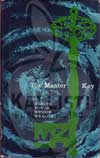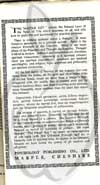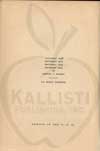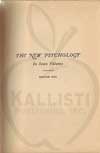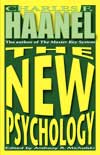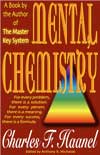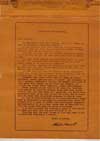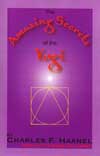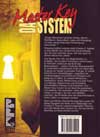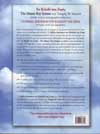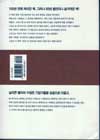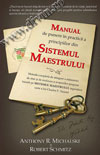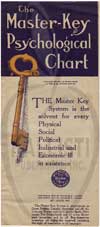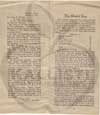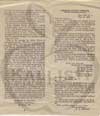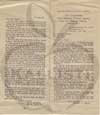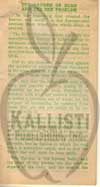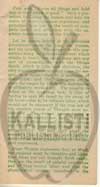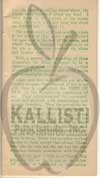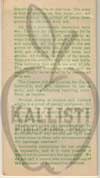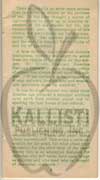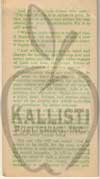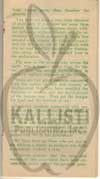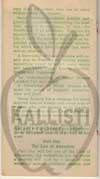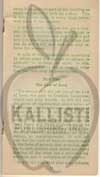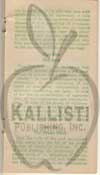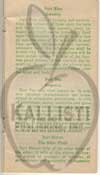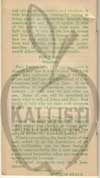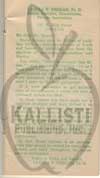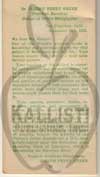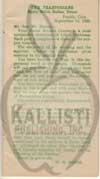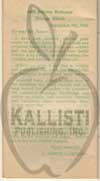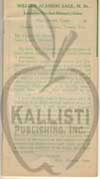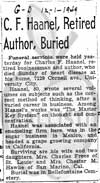Search results for "banned"
The History of The Master Key System and Its Influence on Future Generations
Table of Contents: Introduction • The Context of The Master Key System • The “Master Key” Before the “System” • The New Thought Movement • The Law of Attraction • Hidden and Banned? • The Napoleon Hill Letter • The Bill Gates Connection •The Master Key System Today

The Master Key System header from original correspondence course.
Introduction
The history and background of Charles F. Haanel’s perennial workThe Master Key System is quite interesting, but more blasé than some of the stories would lead you to believe. For example, the belief that Haanel’s books were banned in 1933 and that his publication disappeared from the market is a fabrication. Not only is there no record of a banning (by anyone, including the Roman Catholic Church), it can be shown that he was still advertising, publishing and printing The Master Key System in 1935.
Likewise, the story about Bill Gates reading The Master Key System and it being a “hot commodity” in Silicon Valley is more than likely false as no positive proof could be found to corroborate the story.
Lastly, as was shown in Mr. Haanel’s biography, there as no reason to believe that Haanel wished his work and ideas to be hidden and kept secret amongst a select few. Not only did he market The Master Key System, it is quite probably that he innovated many of the marketing techniques that he used, such as the “correspondence course” to his marketing pamphlets and brochures.
The question most ask is from where did Haanel get his ideas forThe Master Key System? How did it originate? Was Haanel a lone genius that worked in solitude? Did he have influences?
This essay shall endeavor to answer those questions and many more.
(top)
The Context of The Master Key System
The Master Key System must be looked at within the context of the late 19th and early 20th Centuries. The New Thought philosophy was in full swing with many books and magazines publishing the new beliefs for a seemingly ravenous audience. Based on Christian Science as espoused by Mary Baker Eddy, the Christian Scientists and many New Thought-ers held firmly to the belief about what Jesus Christ said about the powers available to each and every person.
“Believe me when I say that I am in the Father and the Father is in me; or at least believe on the evidence of the miracles themselves. I tell you the truth, anyone who has faith in me will do what I have been doing. He will do even greater things than these, because I am going to the Father. And I will do whatever you ask in my name, so that the Son may bring glory to the Father.” (John 14:11-13)
Thus, with enough faith and belief, one could perform miracles as Christ did. Even a cursory reading of The Master Key Systemwould reveal to someone that this was something in which Haanel believed deeply.
That being said, the monotheistic ideas that Haanel espouses is more than likely derived from his participation in Freemasonry. While the Masons do not define their God, their only prerequisite is a belief in one God. It is then through this God that miracles and extreme human potential can occur.
(top)
The “Master Key” Before the “System”
Before going further into this, it is worth pointing out that there were at least two other publications that emphasize the words “The Master Key” prior to the Twentieth Century. The actual phrase has been used since the 17th Century by the Freemasons and in an 18th century publication Hiram, or the Master Key to the Door of Freemasonry, published in 1760.

Isis Unveiled by Madame Blavatsky.
Another use of the phrase can be found in Madame Helena Blavatsky’s famous (or should that be infamous) 600-page Isis Unveiled, with its sub-title A Master-Key to the Mysteries of Ancient and Modern Science and Theology, published in 1877. One shouldn’t underestimate the popularity and influence of Blavatsky and those who followed her teachings — the Theosophists.

The Master Key by Frank Baum. (1901)
In the Twentieth Century, two authors released books with “Master Key” in the title. The first comes from L. Frank Baum, the author of The Wizard of Oz fame, and is an early science fiction novel. It was called The Master Key and subtitled An Electrical Fairy Tale. It told of the adventures Rob and the Demon of Electricity. This was published in 1901.
Another book came out at around the same time Haanel was working on his correspondence school. Its advertisement showed a book and a man reading a book inside an hour glass. The advertisement read:
“The Master Key ~ Reveals Things You Never Thought Possible. The Hour Glass of Success. You Will Never get Another Book Like ‘The Master key’.”

The Master Key by L.W. de Laurence. (1914)
It was written by L. W. de Laurence and published by The de Laurence Company of Chicago, Illinois, USA, in 1914. To quote a few lines from it will show obvious similarities with Haanel’s The Master Key System.
“THE MASTER KEY is divided into Six parts: contains Thirty-seven full Chapters embracing Thirty-five Lessons of graduated difficulty covering Forty individual numbered Exercises in which the fundamental principles of Concentration and Mental Discipline are fully explained.”
L. W. de Laurence, whose full name was Lauron William de Laurence, was an American author, publisher, and owner of a supply mail order house in Chicago. He has been accused of plagiarism and the illegal publication of various occult works. The number of publications by this man seems to be considerable.
De Laurence was active at the same time as Haanel and was in fact only two years younger than him. De Laurence, who was born in 1868 and died in 1936, had connections with AMORC. It is unclear whether there was any connection between the two authors.
(top)
The New Thought Movement
This brings us to the main influence of Charles F. Haanel: the New Thought Movement.
When you read Haanel’s The Master Key System, it isn’t long before he starts to use terms that can be cross-referenced. To be fair to Haanel, many quotes he uses have nothing to do with the New Thought Movement. He was a man of his time and a well-read one. He used references from eminent people of the 19th Century and talks about the inventions of that time and the early years of the 20th Century. Other quotes come from the Bible but all are rather enigmatic and symbolic, which could point to being influenced by New Thought writers, the Christian Scientists, the Freemasons, or the Rosicrucians. There are several hints of a possible knowledge of Hinduism, but it is unclear of Haanel’s exact knowledge of that subject as references like “Pranic Energy” or “Pranic Ether” may be from the Rosicrucian teachings or possibly, and more likely, Theosophy.
There are several words and phrases that may be of interest:
- The “Great Architect of the Universe”
- “Secret Place of the Most High”
- “Universal Mind”
- The “I”
- “The Law of Attraction”
The “Great Architect of the Universe” is a phrase often used to represent God or Supreme Being by Christians, Freemasons, and Rosicrucians. It may go back to the Middle Ages or beyond. Thomas Aquinas used a similar phrase but using “Grand” instead of “Great.”
“Secret Place of the Most High” can be found in the Bible in Psalms 91:1. “He that dwelleth in the secret place of the most High shall abide under the shadow of the Almighty.”
The “Universal Mind” seems to come from Friedrich Von Schelling and was expanded on by Georg W. F. Hegel. Ralph Waldo Emerson also made use of this term.
The concept of the “I” also seems to have its origins in the works of early German philosophers. It would seem that “I” was the first principle of Johann Gottlieb Fichte’s Wissenschaftslehre — “Doctrine of Science.”
(top)
The Law of Attraction
The phrase that is on the tip of the tongues of many today is “The Law of Attraction.” Like the other terms used by Haanel, this was probably not of his own inventing. It seems to have come to light first in the works of William Walker Atkinson (1862 – 1932) and particularly in Thought Vibration or The Law of Attraction in the Thought World published by The New Thought Publishing Co., Chicago, Illinois, USA, 1906. Though the phrase itself is much older, its meaning became somewhat different with Atkinson and Haanel.
The Law of Attraction also appears in the syllabus of the S.R.I.A. — The Society of Rosicrucians. However, it is not known how old this syllabus is and it is likely that it is quite modern. The S.R.I.A. was formed in 1909 with the idea of teaching to the general public rather than Masons as with previous Rosicrucian groups. Some other aspects of the S.R.I.A. syllabus bears similarities to Haanel’s works. However, it may be that both this syllabus and Haanel’s ideas are from an older source — or just a coincidence. It is unknown which came first.
Ultimately it may be possible to trace the idea of the Law of Attraction back to certain phrases from Jesus Christ in the New Testament of the Bible.
“Ask, and it shall be given you; seek, and ye shall find; knock, and it shall be opened unto you: For every one that asketh receiveth; and he that seeketh findeth; and to him that knocketh it shall be opened.” (Matthew 7:7-8, King James Version)

The Kybalion: Hermetic Philosophy by Three Initiates. (1908)
Another book that cannot be ignored was published in 1908 and was called The Kybalion: Hermetic Philosophy by Three Initiates and published by The Yogi Publication Society, Masonic Temple, Chicago, Illinois, USA. It cannot be ignored that this book may have played a part in the development of Haanel’s The Master Key System. It certainly wasn’t a collection of lessons and exercises, but the wording throughout this book is remarkably similar to Haanel’s publications. At one point the phrase “Mental Chemistry” is used, perhaps influencing Haanel’s later work Mental Chemistry. And though there is nothing in the title remotely similar to Haanel’s work, the phrase “Master Key” is used in the Introduction and several times in the body of the book. The Kybalion also delves into the power of thought.
“…[T]he Hermetic Philosophy is the only Master-Key which will open all the doors of Occult teachings…. One of the old Hermetic Masters wrote, long ages ago: ‘He who grasps the truth of the Mental Nature of the Universe is well advanced on the Path to mastery.’ These words are as true today as at the time first written. Without this Master-Key, Mastery is impossible, and the student knocks in vain at the many doors of the Temple…. The Principles of Truth are Seven; he who knows these, understandingly, possesses the Magic Key before whose touch all the Doors of the Temple fly open.”
It is believed that The Kybalion is not some ancient document but was written by William W. Atkinson and the other “Initiates” have been guessed at as Paul Foster Case and Mabel Collins.
Atkinson was certainly active in the years leading up to the publication of The Master Key System and it is hard to believe that Haanel would not have known of either the man or his works.
In the time period in which Haanel lived, the self-help/personal development movement (although not called by those terms) was quite large and actually very similar to today’s “scene.” As the saying goes, the times may have changed but things remain the same. By some counts, Haanel was a somewhat important player, although he never had the infamy of Blavatsky or a few others of the time.
It was all of these elements (at least) that came together in Haanel’s mind to form one of the greatest books about personal development and self-mastery.
(top)
Hidden and Banned?
It has become part of the lore of this book that The Master Key System was sold only to a select few and then at prices well over $1,000. But having helped certain unnamed people to become extremely wealthy, Haanel then made the knowledge available to the great “unwashed masses” at a reasonable price. When the 24 weekly parts were eventually produced in book form it has been stated that 200,000 copies were sold before “the Church” banned it in 1933. After that we are told the book disappears from records.

The Master Key System as published by the New Psychology Publishing Company in 1951.
There is no sign anywhere that Haanel’s book was kept secret or that it was banned by the Church, which can be presumed to bethe Roman Catholic Church. Only one book was banned by the Church in 1933 and that was Congrès d’histoire du christianisme by Jubilé Alfred Loisy. Many versions of The Master Key System have an introduction by Frederick H. Burgess, who seems to be connected with The Master Key Publishing Company in London, and it can be shown that they continued to publish Haanel’s works into the 1940s.
Another point to ponder is what effect the Church banning the book would have. While the Church was a powerful organization at the time, it certainly did not enjoy the power and influence it once held. The United States was a growing industrialized nation based on the separation of church and state. Even if the Church chose to impose a ban on the book, would it have any real effect? Would the book have been taken off the shelves and destroyed — all because the Church said so? In all likelihood, probably not. Unless the community at large became upset with what was written, nothing at all would have happened — and there is no indication that there was any upset at all.
The American Mercury mentioned The Master Key System in 1950 and 1951. There was an advert in a magazine called The Saturday Review, published in 1952, which stated that there was “a scientific method with unlimited potential possibilities in every field of human endeavor.” It also gave an address: “The Mystic Key System, St. Louis, Mo.” Advertisements for Haanel’s publications can be found in 1954 and one version of The Master Key System was published in 1977.
As for Haanel keeping The Master Key System hidden, from the evidence that has been found, nothing can be further from the truth.
For one thing, as has been shown in the previous sections, Haanel’s wasn’t the only book about the mental aspects of success that was written at the time. While the book that Haanel penned was indeed superlative, it wasn’t original, either in message nor in form.
In 1917, “Chas. F. Haanel” ran the following advertisement in The Nautilus, a magazine of the New Thought movement published by Elizabeth Towne. (See Advertisement 1.) The advertisement boldly declared “There is a Master-Key” before making an offer to the reader: “FREE! There is no charge for the Master Key. It is FREE! … NOTE—There is a Master Key for every reader of theNautilus. Write me for yours today!”
Many advertisements for The Master Key System as well as other books that Haanel wrote can be found in the other books that Haanel wrote. In other words, like publishers today, Haanel liked to cross-promote. The ad in Advertisement 2 shows an ad that Haanel used in a later book that he wrote entitled A Book About You.
The last piece, seen in Advertisement 3 and Advertisement 4 are perhaps the most interesting. “The Master Key Psychological Chart” was an advertising brochure Haanel used to entice people to order The Master Key System. In addition to the “Master Key Psychological Chart” that Haanel wrote (the full text can be found in Kallisti Publishing’s Master Key Arcana), it contains a plethora of testimonials for The Master Key System from “students.”
The most interesting part of this brochure, though, is the list of “Master Key Publications” on the back. Items — presumably advertising materials of some sort — could be bought for ten cents a piece. On the bottom of the page, Haanel implores the reader to “Send Master Key Literature to you Friends.”
 Advertisement for The Master Key System as it appeared in The Nautilus in 1917. |
 Another advertisement for The Master Key System. |
With all this evidence, does this sound like a person who wished to keep what he had hidden? Haanel advertised in magazines. He advertised in his books. He produced and sold marketing materials. The answer is an overwhelming negative.
In fact, it can be posited that Haanel was quite ahead of his time with his marketing techniques. The practice of offering The Master Key System as a correspondence course in which chapters were sent one at a time and for which the student paid per section effectively tripled — or even quadrupled! — the cost of the “System” had he sold it simply in book form.

Charles F. Haanel’s General Instructions to Students.
In his “General Instructions to Students,” Haanel wrote this: “The bound volume is never sold to any one at any price, unless they have completed the study and made payments in full.” In other words, Haanel had the student pay for each section of the course and then had them buy the book.
(Other aspects of the “General Instructions” are interesting as well. “Students who complete the course and who hold a receipt in full for all payments, will be entitled to receive a diploma.” What is this diploma? That has not been answered. A “diploma” — or as it is also called, “The Fellowship Diploma” — has not been found as of the writing of this article.)
Obviously Haanel was a smart man. He was not only educated, but he marketed intelligently. That being stated, whether The Master Key System was a success or not cannot be determined. The 200,000 sales number that is often quoted cannot be verified. It can be extrapolated that if 200,000 copies of the book were sold, then we would have more examples of it in existence today. We do not.
(top)
The Napoleon Hill Letter
In 1919, future author of probably the best-known personal development book Think & Grow Rich, Napoleon Hill, penned a letter to Charles F. Haanel about the influence The Master Key System had on him.
In the letter Hill wrote “I believe in giving credit where it is due, therefore I believe I ought to inform you that my present success and the success which has followed my work as President of the Napoleon Hill Institute is due largely to the principles laid down in The Master-Key System.”

The letter Napoleon Hill wrote to Charles F. Haanel about the influence of The Master Key System on Hill’s life.
The letter in its entirety reads:
“April 21, 1919.
“Mr. Charles F. Haanel,
“St. Louis, Mo.
“My dear Mr. Haanel:
“You probably know, from the editorial in the January issue of the Golden Rule, copy of which my Secretary sent to you, that I began twenty-two years ago as a coal miner at a dollar a day.
“I have just been retained by a ten million dollar corporation at a salary of $105,200.00 a year, for a portion of my time only, it having been agreed that I shall continue as editor of the Hill’s Golden Rule.
“I believe in giving credit where it is due, therefore I believe I ought to inform you that my present success and the success which has followed my work as President of the Napoleon Hill Institute is due largely to the principles laid down in The Master-Key System.
“You are doing a good work by helping people to realize that nothing is impossible of accomplishment which a man can create in his imagination. Surely my own experience proves this.
“I shall cooperate with you in getting your course into the hands of the many who so greatly need your message.
“Cordially and sincerely,
“Napoleon Hill,
“Editor, The Golden Rule
“Chicago, Illinois”
The fact that Hill entitled one of his later books The Master-Key to Riches reinforces the fact that Haanel was a direct influence on Napoleon Hill.
(top)
Did Bill Gates of Microsoft Read The Master Key System?
Somewhere around 2001, a story began to appear on the Internet. The “rumor,” as it was called, stated that while Bill Gates was a student at Harvard, he came across a copy of The Master Key System. After reading it, he proceeded to drop-out of school and begin Microsoft, which lead to him becoming the richest man in the world.
This story has never been verified. That being said, much of it doesn’t make sense. For starters, Gates showed an early proclivity for computer programming. Added to that was that fact that his family was somewhat well-off, which allowed him to pursue his interest in that activity. From Wikipedia:
“He scored 1590 out of 1600 on the SAT and enrolled at Harvard College in the autumn of 1973. While at Harvard, he met Steve Ballmer, who later succeeded Gates as CEO of Microsoft. In his sophomore year, Gates devised an algorithm for pancake sorting as a solution to one of a series of unsolved problems, presented in a combinatorics class by Harry Lewis, one of his professors. Gates’ solution, which was later formalized in a published paper in collaboration with Harvard computer scientist Christos Papadimitriou, held the record as the fastest version for over thirty years; its successor is faster by only one percent. Gates did not have a definite study plan while a student at Harvard and spent a lot of time using the school’s computers.”
In other words, he was smart — very smart — and he practiced his craft relentlessly. Would there even be time to peruse a book as dense as The Master Key System?
His decision to drop-out of school was not done on a whim either. From Wikipedia:
“He remained in contact with Paul Allen, joining him at Honeywell during the summer of 1974. The following year saw the release of the MITS Altair 8800 based on the Intel 8080 CPU, and Gates and Allen saw this as the opportunity to start their own computer software company. He had talked this decision over with his parents, who were supportive of him after seeing how much Gates wanted to start a company.”
It seems from this — as well as other sources — the decision to start “Micro-Soft” was a decision made by both Gates and his friend Paul Allen (Microsoft’s co-founder). Additionally, Gates consulted his parents on his decision.
In all likelihood, the story of Bill Gates reading The Master Key System is something that was created by a savvy marketer and has no basis in truth.
(top)
The Master Key System Today
Since 2000, when Kallisti Publishing began publishing The Master Key System, there has been a renewed interest in Charles F. Haanel. The surprising success of the 2006 movie The Secret only amplified that interest as the movie used Haanel’s perennial book as the basis for the film and quoted from it extensively in the companion book.
The Master Key System and all of Haanel’s works are kept alive by Kallisti Publishing and Anthony Michalski, who since 2000 have published the de facto versions of all of Haanel’s materials. Mr. Michalski writes articles and speaks extensively about the man and the philosophy and is considered the world’s foremost authority on the subjects.
Haanel’s philosophy continues to inspire people around the world and educate them in a form of self-mastery that, while not actually read by Bill Gates, definitely delineates the method of thinking Gates used. People around the world attribute their successes to their study and application of The Master Key System. With his books now in the open, it is safe to say that Charles F. Haanel is here to stay.
(top)
The Books and Writings of Charles F. Haanel
Over the course of his lifetime, Charles F. Haanel wrote five known books and four known pamphlets or marketing pieces. There are also mentions of books that he wrote (either in marketing pieces or in the US Copyright Office) for which examples could not be found, so it is unknown if they were ever published or, if they were, if there are any copies surviving today.
The following will display the books and marketing pieces that Haanel wrote and how they appeared throughout the years.
Table of Contents: The Books: The Master Key System • The New Psychology • Mental Chemistry • A Book About You • The Amazing Secrets of the Yogi • The Master Key System Around the World The Marketing Pieces: The Master Key • The Master Key Psychological Chart • The Garden of Eden and the Sex Problem (Social Science) • Is There a Master Key? • Astrological Playing Cards
The Books of Charles F. Haanel
The Master Key System (c. 1912 ?)
As was discussed in the history of The Master Key System, the book was never banned and has been in publication in one form or another over the years. It is interesting to note how it grew from a correspondence course (of sorts) into a book.
(top)
The New Psychology (1920)
(top)
Mental Chemistry (1922)
 Mental Chemistry as published in 1922. |
 The original title page for Mental Chemistry. |
(top)
A Book About You (1927)
Haanel’s 1927 work A Book About You delved into many areas of interest: physics, astrology, religion. It appears that some editions were custom made for the person. This example has on the cover in addition to the title “For Carrie A. Hall.”
 A Book About Youas originally published in 1927 with “For Carrie A. Hall” on the cover. |
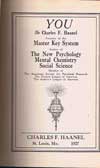 The original title page for A Book About You. |
(top)
The Amazing Secrets of the Yogi (1937)
(top)
The Master Key System and Other Books by Haanel Around the World
The Master Key System and other works by Charles F. Haanel have been translated into different languages around the world. Here are a few examples of how the books look in different countries.
BrazilThe New Psychology as published in Brazil by Centro de Estudos Vida & Consciencia Editora Ltda. |
|
ChinaThe Master Key System and The Master Key Workbook as published in China by Beijing Holy Bird Publishing. |
|
GermanyThe Master Key System and Master Key Arcana as published by RaBaKa Publishing. |
|
GreeceThe Master Key System and The Master Key Workbook as published by Kinitron Publications. |
|
IndiaThe Master Key System as published by VASAN Publications. |
|
South KoreaThe Master Key System as published by Shanti Books. |
|
RomaniaThe Master Key System and The Master Key Workbook as published by Adevar Divin. |
|
UkraineThe Master Key System as published by Sophia Publishing House. |
|
(top)
The Marketing Pieces (Pamphlets) of Charles F. Haanel
The Master Key (1916)
This small book is what Haanel used to market his course The Master Key System. This is what one would receive if they responded to one of his advertisements. Inside are essays by Haanel, reviews, and “appreciations,” or as we know them today, “testimonials.”
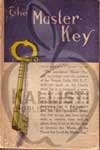 The Master Key is a marketing piece that Haanel used for The Master Key System. |
 The opening page to The Master Key. Shows copyright date. |
(top)
The Master Key Psychological Chart (1916)
The Master Key Psychological Chart was another marketing piece that Haanel used. The essay within it, written most likely by Haanel, guided the reader into testing him- or herself as to how efficiently they were using their mental facilities. There are also a number of “appreciations” scattered throughout the pamphlet.
The back cover is of particular interest as it has a list of other brochures that a person can purchase for as little as ten cents a piece. At the bottom of the page, Haanel implores readers to “Send Master Key Literature to your Friends.”
Here is The Master Key Psychological Chart in its entirety — from front to back.
(top)
The Garden of Eden and the Sex Problem – Social Science (1925)
While we know that Haanel’s book Social Science was copyrighted, we do not have an example of it. So far, the only evidence that it was perhaps in existence is this advertising pamphlet that was produced. Entitled “The Garden of Eden and the Sex Problem,” it contains an essay by Haanel, a chapter listing of the book Social Science, testimonials, and an order form for the course.
It appears that Social Science was sold in installments. The order form on the last page states that the person would “at the rate of $4.00 per month for three months.” The installments would then be mailed one part per week over a period of twelve weeks. The person ordering could receive the entire course in one shipment and save 10% if $10.80 were paid in full.
Here is the entire “The Garden of Eden and the Sex Problem” for your reading pleasure.
(top)
Is There a Master Key? (1927 ?)
This little pamphlet, although written by Bernard Guilbert Guerney and not Haanel, includes some very interesting pages and images. Haanel appears to have written a small piece that appears at the front of the pamphlet that is about Mr. Guerney.
While some of the text is interesting, the pictures are what makes this little work fascinating. The pictures supposedly show the printing department, the correspondence department, and the general offices of The Master Key System.
 Is There a Master Key? by Bernard Guilbert Guerney. (Front Cover) |
 Is There a Master Key?. Opening pages. |
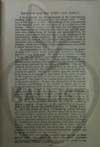 “Thought and the Everyday World” from Is There a Master Key? by Bernard Guilbert Guerney. |
 The Master Key System Correspondence Department. |
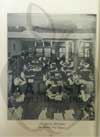 The Master Key System General Offices. |
 The Master Key System Printing Department. |
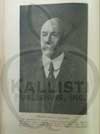 Orison Swett Marden. |
 Letter from Orison Swett Marden to Charles F. Haanel. |
(top)
Astrological Playing Cards (1933)
Here’s an oddity: Astrological playing cards by Charles F. Haanel, copyrighted in 1933.
(top)
Biography and Genealogy of Charles F. Haanel
Table of Contents: Introduction • Charles Francis Haanel (May 22, 1866 – November 27, 1949) • Work and Business Experience• Enter the Master Key System • Complaints and Political Intrigue? • Books After The Master Key System • Haanel’s Final Years • The Final Analysis? • History of the Haanel and Fox Families and Other Family Members • Footnotes • Sources
Charles Francis Haanel and the Haanel Family
Introduction
Most biographies on Charles F. Haanel, author of The Master Key System, are based on one article from Walter B. Stevens’ St. Louis – History of the Fourth City (1909), and most biographies of the man contain mistakes, misinterpretations, or down-right lies. For example, the belief that Haanel’s books were banned in 1933 and that his publication disappeared from the market is a fabrication. Not only is there no record of a banning (by anyone, including the Roman Catholic Church) in 1933, but it can be shown that he was still advertising, publishing, and printing The Master Key System in 1935.
Researching and compiling this biography of Charles F. Haanel has been a monumental task. The research was often beset not only by the factor of the length of time that has passed, but also by the fact that not much was written about Haanel. Thus, source documents were scarce and the data that has been compiled was done so by “connecting the dots” rather than by direct associations.
This biography is the most thorough available about him. His family history was discovered as well as many of his business interests.
While this biography will illuminate Haanel’s influences, his business dealings, and even some portions of his family life, it cannot tell you what were his motives for writing his books. It also cannot tell you what Haanel really was like as a man. It is hoped, though, that this biography will give the reader some insight into the man who has in the present day become more known through rumor and innuendo rather than facts.
(top)
Charles Francis Haanel (May 22, 1866 – November 27, 1949)
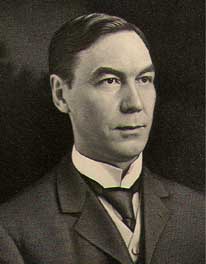 Charles Francis Haanel was born on May 22, 1866 in Ann Arbor, Washtenaw County, Michigan, in the United States of America. (1) He was the first child and son of Hugo Paul Haanel and Emeline Cordelia Fox. The Haanel family soon moved from Michigan to St. Louis, Missouri, when Hugo took a job as a teacher at the Picker School. Following their arrival in St. Louis, the Haanel family grew and seven more children were born after Charles, though only five grew to adulthood. These were Clara C. (February 1872), Julius Bernard (November 1873), Honora I. (November 1875), Alice (January 1878) and Hugo Paul, junior (February 1881). In the 1870s, the Haanels lived at 1012 Wash and then moved to 1131 North 19th, where the family was still living in the 1890s. Later they moved to 3106 School and then 4718 Labadie.
Charles Francis Haanel was born on May 22, 1866 in Ann Arbor, Washtenaw County, Michigan, in the United States of America. (1) He was the first child and son of Hugo Paul Haanel and Emeline Cordelia Fox. The Haanel family soon moved from Michigan to St. Louis, Missouri, when Hugo took a job as a teacher at the Picker School. Following their arrival in St. Louis, the Haanel family grew and seven more children were born after Charles, though only five grew to adulthood. These were Clara C. (February 1872), Julius Bernard (November 1873), Honora I. (November 1875), Alice (January 1878) and Hugo Paul, junior (February 1881). In the 1870s, the Haanels lived at 1012 Wash and then moved to 1131 North 19th, where the family was still living in the 1890s. Later they moved to 3106 School and then 4718 Labadie.
The first census to possibly show the Haanel family is the one for 1870 and they are under the name “Heimell.” They consisted of Hugo (though the initial is given as “C”), aged 35, and wife Emelia (26) with son Charles, aged 4. Hugo is shown as being born in Prussia and Emelia as being born in Wisconsin, while Charles was born in Michigan. They were residing in St. Louis and C. Haanel’s occupation was a retired minister. It is possible that this is a different family, but a St. Louis directory shows that Hugo Haanel was living at 1012 Wash, St. Louis in 1871. He was recorded as being principal of the Picker School. A year later he was principal of the North School of the Church of the Holy Ghost. (Both schools were connected with the Rev. Frederick Picker who was a minister in St. Louis in the 1840s and 1850s.)
(top)
Work and Business Experience
 Charles attended public schools in St. Louis and then got his first full-time job at the National Enameling and Stamping Company as an office boy in 1886. This company had been formed by the Neidringhaus brothers, Frederick and William, from Westphalia, Germany. Charles worked there for 15 years (2) and may have also attended college as the 1885 St. Louis Directory has the abbreviation “coll.” next to his name.
Charles attended public schools in St. Louis and then got his first full-time job at the National Enameling and Stamping Company as an office boy in 1886. This company had been formed by the Neidringhaus brothers, Frederick and William, from Westphalia, Germany. Charles worked there for 15 years (2) and may have also attended college as the 1885 St. Louis Directory has the abbreviation “coll.” next to his name.
During the time Charles worked at the National Enameling and Stamping Company he met Esther Martha Smith. They were married on November 22, 1888. Esther was born in 1866 and was the daughter of Irish parents Samuel and Jane Smith. Their marriage lasted 16 years and they had four children: Jennie, sometimes known as Jane or Jean (September 1889); Esther (January 1892); Walter (April 1894); and Edith (June 1898).
In 1885, Charles went into the publishing business and after buying out his partners, set up the C.F. Haanel Publishing Company with offices at 4723 Greer Avenue. These publishing companies published illustrated magazines such as Illustrated Monthly (later called The Home Circle) until 1896. It is uncertain whether Haanel had this business while employed at the National Enameling and Stamping Company or if he took a leave of absence.
Later, Charles, from the same offices, was first secretary and then president of several companies including the Oaxaca Coffee Culture Company, the Continental Sugar Company, and the Continental Commercial Company. The latter was still trading in 1907, but in 1910 Charles was president of the Sacramento Valley Improvement Company. His brother Julius Bernard, who had worked as a clerk at the National Enameling and Stamping Company and a cashier in the Continental Commercial Company, moved to Sacramento, California, where he was vice president of the Sacramento Valley Improvement Company. (In 1910, Julius had married May (Mae) Robinson and had two children: McKee and Marian.)
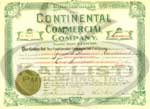 According to Walter B. Stevens, the Continental Commercial Company was one of the largest companies in the world and “capitalized for two million five hundred thousand dollars.” Stevens also wrote about how Haanel, having left the National Enameling and Stamping Company, convinced “a number of capitalists” to purchase land in the vicinity of Tehuantepec, Mexico, for the growing of sugar and coffee. He went on to tell that this was organized in 1898 and the Continental Commercial Company was set up in 1905.
According to Walter B. Stevens, the Continental Commercial Company was one of the largest companies in the world and “capitalized for two million five hundred thousand dollars.” Stevens also wrote about how Haanel, having left the National Enameling and Stamping Company, convinced “a number of capitalists” to purchase land in the vicinity of Tehuantepec, Mexico, for the growing of sugar and coffee. He went on to tell that this was organized in 1898 and the Continental Commercial Company was set up in 1905.
It can be shown that the Continental Commercial Companywas established in August 1905, had offices in the Commonwealth Trust Building, St. Louis, and that its directors were
- Thomas Hennings – President
- C. H. McKee – Vice-president (3)
- J. E. Carnahan
- A. P. Erker
- Chas. W. Owen
The Continental Commercial Company controlled the following companies and plantations:
- The Continental Sugar Refining Co.
- The Oaxaca Coffee Culture Co.
- The Mount Rosa Land and Cattle Co.
- The Iolita Plantation
- The Pittsburgh Plantation Co.
- The Jumiapa Plantation
- The Mount Verde Plantation
![]() It is also recorded that the Company had 18,000 acres of land in Mexico and 1,000,000 coffee trees. (4)
It is also recorded that the Company had 18,000 acres of land in Mexico and 1,000,000 coffee trees. (4)
The Sacramento Valley Improvement Companyseems to have prospered for a while and was described as “controlling the largest Tokay vineyards in the world.” However, the California project seems to have folded after 1911. People purchased two acre parcels of Tokay grapes and ten acre parcels of eucalyptus at $600 and $2,000. There were hundreds of buyers, but the venture was unsuccessful and after a few years the company was dissolved. Julius B. Haanel, who had been vice-president of the company, left California and went to live in Chicago.
Charles Haanel’s wife Esther died on April 18, 1904. The cause of her death remains unknown. Four years later on July 8, 1908 he married Margaret S. Nicholson, daughter of William and Margaret Nicholson. Margaret (who seems to have been known to her family as Pearl) was born October 28, 1882 in St. Louis. By 1920, Charles had two more children: Beverley (1911) and Charles F., Jr. (1914).(5)
(top)
Enter the Master Key System
Sometime after 1911 Charles began to publish The Master Key System in weekly parts. It is unclear why and when Haanel changed from a trading company president into an author. It would seem that the earliest versions of The Master Key System consisted of 24 lessons, which were later bound into book form and published in 1916.
While publishing his correspondence course, Haanel advertised in various magazines and journals. One of these was The Nautilus (published from 1898 to 1953), which was in the forefront of the New Thought Movement and published by William and Elizabeth Towne. Haanel began by offering a free booklet called The Master Key. (This little booklet makes quite interesting reading on its own and the complete text can be found in Kallisti Publishing’sMaster Key Arcana.)
 The Master Key was an introduction and a sales pamphlet to Haanel’s The Master Key System, which he said “…teaches the use of Mind Power — true Mind Power — not any of the substitutes and perversions. It has nothing to do with Hypnotism, Magic, or any of the more or less fascinating deceptions by which many have been led to think that something can be had for nothing.” He ended the pamphlet with the penultimate paragraph stating: “The Master key System comes in twenty-four parts, one part is mailed each week. Each part has a series of questions by which your understanding of the lesson is tested…”
The Master Key was an introduction and a sales pamphlet to Haanel’s The Master Key System, which he said “…teaches the use of Mind Power — true Mind Power — not any of the substitutes and perversions. It has nothing to do with Hypnotism, Magic, or any of the more or less fascinating deceptions by which many have been led to think that something can be had for nothing.” He ended the pamphlet with the penultimate paragraph stating: “The Master key System comes in twenty-four parts, one part is mailed each week. Each part has a series of questions by which your understanding of the lesson is tested…”
It is said that The Master Key System began to be published in 1912 but I haven’t been able to find any independent references to this. Directories have Haanel occupying offices 411 at 406 Market in 1915 and running a correspondence school at 709 Pine by 1918. Though web sites and publications often state the year 1912 (and some 1909) I cannot be sure of anything before 1916 when it can be shown that Haanel copyrighted The Master Key System.
The Master Key System in book form was advertised in many different publications. The cloth cover version of the book was $3.60 and the deluxe version $5.40. Now this isn’t a cheap book and would sell today around the same price as the final “door stopper” in the Harry Potter series (hardback and deluxe versions being $34.99 [£17.99] and $65.00 [£35.00] respectively), though with less than half the pages.
(top)
Complaints and Political Intrigue?
Whatever the level of success attained by Haanel’s book, what can be said is that possible complaints can be found in some very interesting places.
Following the 1920 Presidential Elections, a report was made by the United States Congress, Senate Committee on Privileges and Elections. In this there is a specific mention of Haanel. Only a snippet of the discussion was obtainable. Obviously, something interesting to the Committee was published by Haanel. The quote is thus:
“The CHAIRMAN. Charles F. Haanel, 707-709-711 Pine Street, St. Louis, Mo., seems to be the author. You have no knowledge of who would be sending out syndicated articles that appear in the papers concerning the League of Nations?”
The person answering the questions seems to be a Mr. Moore, but that is all that can be ascertained of this enigmatic snippet. It can be found on page 2227 of Presidential Campaign Expenses: Hearing[s] Before a Subcommittee of the Committee on Privileges and Elections (unknown volume), published in Washington, DC, in 1921.
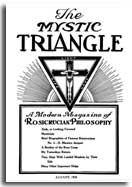 The second mention of Haanel may be more interesting. In The Mystic Triangle, for December 1928, there is an “Important Notice.” It stated that someone was writing letters using AMORC letterhead paper and they seemed to say that AMORC endorsedThe Master Key System. The notice said that members of AMORC were confused by this and that AMORC would look into this. It emphasized that in no way had there been an endorsement of the above mentioned publication.
The second mention of Haanel may be more interesting. In The Mystic Triangle, for December 1928, there is an “Important Notice.” It stated that someone was writing letters using AMORC letterhead paper and they seemed to say that AMORC endorsedThe Master Key System. The notice said that members of AMORC were confused by this and that AMORC would look into this. It emphasized that in no way had there been an endorsement of the above mentioned publication.
AMORC stands for the Ancient Mystical Order Rosae Crucis, an American organization affiliated to the Rosicrucian Order in Europe and found by H. Spencer Lewis in 1915. Their journal from 1925 to 1929 was called The Mystic Triangle.(6)
Finally, in 1927, Haanel was singled out by none other than Upton Sinclair in his The Profits of Religion (1927). In the chapter “New Nonsense,” Mr. Sinclair unleashes a tirade against the New Thought practitioners and focuses on an advertisement in the magazine The Nautilus.
“I look over this Priestess’ [referencing the editor of The Nautilus, Elizabeth Towne] magazine, and find it full of testimonials and advertisements for the conjuring of prosperity. ‘Are you in the success sphere?’ asks one exhorter; the next tells you ‘How to enter the silence. How to manifest what you desire. The secret of advancement.’ Another tells: ‘How a Failure at Sixty Won Sudden Success; From Poverty to $40,000 a year — a Lesson for Old and Young Alike.’ The lesson, it appears, is to pay $3.00 for a book called ‘Power of Will.’ And here is another book:
“Master Key: Which can unlock the Secret Chamber of Success, can throw wide the doors which seem to bar men from the Treasure House of Nature, and bids those enter and partake Who are Wise enough to Understand and broad enough to Weigh the Evidence, firm enough to Follow their Own Judgment and Strong enough to Make the Sacrifice Exacted.”
Nothing more could be found about these references. Did Haanel have intrigue regarding the League of Nations? Did he misappropriate AMORC letterheads? Why was Haanel mentioned in a Congressional committee meeting?
Regarding the Rosicrusians, it is known that Haanel was a member of the Keystone Lodge No. 243, AF & AM, a 32nd degree Mason, and a Shriner – Noble in the Moolah Temple. It has also been stated that he was a member of the Society of Rosicrucians. Haanel was initiated into the Keystone Lodge #243 in Webster Groves, St. Louis, on May 4, 1904 and by July 13th was a Master Mason. He also became a member of the Ancient Arabic Order of the Mystic Shrine on October 29, 1904. Haanel never held office in the Masons and was suspended on November 20, 1935 for non-payment of dues.
(top)
Books After The Master Key System
Following The Master Key System, Haanel wrote several more books of a similar nature. These included:
- The New Psychology (1920)
- Social Science (1922)
- Mental Chemistry (1922)
- A Book About You (1927)
- The Amazing Secrets of the Yogi, with Victor S. Perera (1937)
Several of these books seem to be bound versions of publications of a smaller nature such as Cause and Effect (1922). It is also possible that the latter was an alternative title for one of Haanel’s other books. It is highly likely that Haanel also wrote articles for various magazines and journals, but as of the writing of this article, none have been found.
 Charles F. Haanel’s listing in Who’s Who Among North American Authors 1929-1930. (1) |
 Charles F. Haanel’s listing in Who’s Who Among North American Authors 1929-1930. (2) |
(top)
Haanel’s Final Years
In 1925, the St. Louis Directory had Charles F. Haanel as publisher of “The Master Key” with offices on the 2nd floor of the Lesser Building on 704 9th and residing at 5032 Cabanne. By 1930 he was living at 7129 Cornell Avenue, University City and in 1935 he as a printer with offices at 3847 Washington Boulevard. It would seem that Haanel retired after this and later directories (1941 and 1946) only record his and Margaret’s residence at 7129 Cornell. By this time Haanel’s immediate family had all married or died, as in the cases of Edith and Charles, Jr.
Charles Francis Haanel passed away at 1:15 PM on November 27, 1949, aged 83 years old. His death certificate states the cause of his death was unknown. A private ceremony was held at C. R. Lupton & Sons Funeral Director’s chapel at 10:00 AM on November 30th and he was buried at Bellefontaine Cemetery at 11:00 AM the same day. Margaret Haanel (nee Nicholson) survived her husband by two years and died of a cerebral hemorrhage at the De Paul Hospital on October 2, 1951.
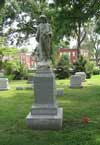 The Haanel and Nicholson families have plots (4646 Block 6 and 4143 Block 29-38) in Bellefontaine Cemetery. Included in the Haanel plot are Charles F., his parents Hugo and Emeline, his daughter Edith Ione, and his first wife Esther. There is also the burial of an unnamed infant child of Charles W and Jane Frees. Near the plot is a monument to Esther and Edith, presumably set up by Charles. In the Nicholson family plot can be found Haanel’s second wife Margaret, her parents, her siblings and, interestingly, Charles F. Haanel junior. Other members of the Haanel family are buried in Chicago.
The Haanel and Nicholson families have plots (4646 Block 6 and 4143 Block 29-38) in Bellefontaine Cemetery. Included in the Haanel plot are Charles F., his parents Hugo and Emeline, his daughter Edith Ione, and his first wife Esther. There is also the burial of an unnamed infant child of Charles W and Jane Frees. Near the plot is a monument to Esther and Edith, presumably set up by Charles. In the Nicholson family plot can be found Haanel’s second wife Margaret, her parents, her siblings and, interestingly, Charles F. Haanel junior. Other members of the Haanel family are buried in Chicago.
From two families with interesting pasts, Haanel must have inherited something from each. Hugo Haanel was both a teacher and author, while Uncle Eugene was a prominent scientist who, on his death, was given a long obituary in The Times of London. The Foxes were farmers descended from pioneers and in one case an inventor. Sister Honora Soward seems to have been a member of the New Thought Movement and was a Christian Science practitioner. However, little else can be found to explain why a businessman with a finger in many pies began to write books of a spiritual and self-improvement nature.
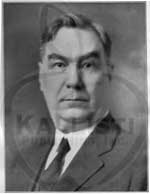 First and foremost, Haanel must be considered to have played a part in the New Thought Movement while certainly being influenced by that Movement. Several members of the Movement are quoted in his publications and the terminology used throughout his works seems to stem from this 19th century — primarily American — phenomenon. Between the publication of The Master Key System and The Amazing Secrets of the Yogi, Haanel became interested in religions other than the rather Christian-based New Thought Movement. What caused this interest, though, is anyone’s guess.
First and foremost, Haanel must be considered to have played a part in the New Thought Movement while certainly being influenced by that Movement. Several members of the Movement are quoted in his publications and the terminology used throughout his works seems to stem from this 19th century — primarily American — phenomenon. Between the publication of The Master Key System and The Amazing Secrets of the Yogi, Haanel became interested in religions other than the rather Christian-based New Thought Movement. What caused this interest, though, is anyone’s guess.
(top)
The Final Analysis?
The only description of Charles F. Haanel the man is from Walter B. Stevens.
“He is a man of mature judgment, capable of taking a calm survey of life and correctly valuing its opportunities, its possibilities, its demands and obligations. He has wisely sought success along the lines of least resistance and yet when difficulties and obstacles have confronted him he has displayed a force of character that has enabled him to overcome them and continue on the pathway to prosperity. Many a man whose life is one of untiring industry does not win success for he lacks the complement to industry a laudable ambition which prompts the individual to reach out into other fields and eagerly grasp the opportunities that are presented. In these qualities Mr. Haanel is richly endowed and has thus attained his present enviable position in financial circles.”
Any other information about Haanel the man has proven to be unobtainable. The closest relatives that were able to be interviewed were great-nieces and -nephews. One great-nephew remembered visiting his “crazy uncle Charlie’s” house and remembered him as being a nice old man, but nothing further.
It should also be noted that for someone who created a significant amount of wealth in his lifetime, there appears to have been no great estate that was passed after Mr. Haanel died. While it appears that Haanel was not poor when he died, it also does not appear that he lived a “millionaire lifestyle.”
It has been posited by some (although there are no references) that Haanel was not writing or publishing in the years preceding his death. It appears that Haanel’s last book was The Amazing Secrets of the Yogi (1937). From 1937 until his death in 1949, what did he do? Some have posited that he simply retired. Others have theorized that he became sick and therefore retired for health reasons. Until further information can be obtained, the answer will remain a mystery.
In many ways, Haanel was a man ahead of his time. His perennial tome The Master Key System successfully combined various philosophies and teachings into an accessible volume for the every-man describing a complete method of success. This book was not only successful in his day, but was very influential for future self-help legends, such as Claude M. Bristol (author ofThe Magic of Believing) and Napoleon Hill (author of Think & Grow Rich).
Haanel proved to be more visionary in his later writing as he explored various religious experiences, Eastern philosophy, and Biblical interpretation, as well as sundry explorations into psychology, theology, and the sciences.
His methods of marketing from the “correspondence course” to the sundry pamphlets and brochures he used prove him to have been an astute businessman. The methods he used — and perhaps innovated — are still used today with great success.
The world is a richer place because Charles F. Haanel was in it — not only because of the books he wrote and published that exist over fifty years after his death, but because of the life he lead and the example he set. Of all the authors in the self-help genre, Haanel was a person who not only talked the talk, he also walked the walk.
(top)
History of the Haanel and Fox Families and Other Family Members
For a detailed history and genealogy of the Haanel and Fax families as well as a biography of Charles F. Haanel’s uncle Eugene Haanel and his family, please see the following links.
History of the Haanel and Fox Families
Walter B. Stevens’ Biography of Haanel from St. Louis — History of the Fourth City
(top)
Footnotes
(1) Haanel’s death certificate states he was born in Lansing, Ingham County, Michigan. (back)
 (2) On p. 246 of The Book of St. Louisans: a biographical dictionary of leading living men of the city of St. Louis and vicinity (1906), it is stated that Haanel began work at the National Enameling and Stamping Company in 1886 and “remained with that company until Oct., 1904, when he took present position as president of the Continental Commercial Co., wholesale sugars and coffee.” While Walter B. Stevens wrote “He initiated himself into the business world as an office boy for the National Enameling and Stamping Company.” Directories, however, show that Haanel was connected with publishing in 1890 and 1895 and that he was secretary of the Oaxaca Coffee Culture Company in 1901. (back)
(2) On p. 246 of The Book of St. Louisans: a biographical dictionary of leading living men of the city of St. Louis and vicinity (1906), it is stated that Haanel began work at the National Enameling and Stamping Company in 1886 and “remained with that company until Oct., 1904, when he took present position as president of the Continental Commercial Co., wholesale sugars and coffee.” While Walter B. Stevens wrote “He initiated himself into the business world as an office boy for the National Enameling and Stamping Company.” Directories, however, show that Haanel was connected with publishing in 1890 and 1895 and that he was secretary of the Oaxaca Coffee Culture Company in 1901. (back)
(3) His full name was Charles Henry McKee. He was vice-president of the Globe Democrat newspaper at the time and later president and editor of the newspaper. He died on December 19th 1918, aged 65. (back)
(4) According to Gould’s St. Louis Red Book, the Continental Commercial Company was still trading with Hennings as president and McKee as vice-president in 1914. There is no mention of Haanel, but a 1905 directory certainly has him listed as president of this company. (back)
(5) As for Charles’ other children, Jennie had married Charles Frees of St. Louis in 1915. Beverley married Chester Hawke and went to live in San Marino, California. Charles, Jr. joined the US Army Air Corps in 1941 and died following an automobile accident on April 2, 1942. Esther and Walter remain partial mysteries. Walter is recorded as having died in California in 1967. He is not mentioned in Charles F. Haanel’s obituary, so it is possible they had become estranged. Esther was a teacher at the Devonshire School and living with her parents in 1918. In 1920 she was still with Charles and Margaret at 5032 Cabanne Avenue, St. Louis, and still a teacher, but no further references for her after this date could be found. (back)
(6) Today it is known as The Rosicrucian Digest. (back)
(top)
Sources
A listing of sources used in researching this biography of Charles F. Haanel and the Haanel family can be found here.
(top)





